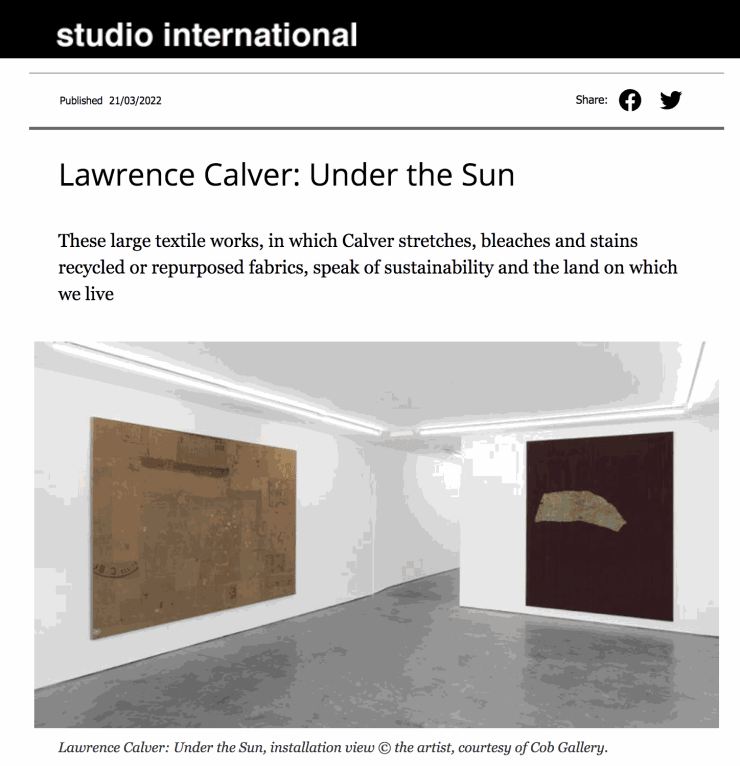Under the Sun: Lawrence Calver
Cob Gallery is proud to present ‘Under the Sun’, a new solo exhibition of large-scale textile works by Lawrence Calver.
Calver’s practice is built around sourcing and repurposing textiles into arresting abstract compositions. Working mostly within restricted colour palettes, he has developed a language that is as haptic as it is visual. Using processes including embroidery, stitching and sewing, as well as bleaching, dying and staining, he draws out striking, sensitive conjunctions of texture and tactility.
Calver sees his work as a process of choreography of already-existing materials. Prompted by the rich character and histories of his chosen fabrics, the artist takes up the role of director, mediating between the energies and temperaments of his cast. A process of improvisation, experimentation and realisation sees his source material reconfigured into new dialogues and compositions.
For ‘Under the Sun’, Calver has sourced linen, silk, sackcloth and other fabrics from around the world, apt to the proverbial phrase ‘everything under the sun’. This provenance establishes the theme of a global archive, while subtle material continuities between the works develop the effect of a coordinated ensemble or constellation within the gallery space. Many of the pieces bear a clear relationship to the sun, too: the huge ‘Rising Sun’ forms a natural focal point, suspended above the other works, while ‘Lotus’, ‘Vine’, ‘Horizon’ and ‘Surface to Air’ all play on this theme, pointing to the textiles’ character as natural materials produced out of the sun’s energy.
The stunning stitched-linen piece ‘Sunlight’ is made from antique French curtains whose discolouration has been caused by decades of exposure to sunlight. Like a photograph taken over the course of decades, the work’s tonality is therefore not only an allusion to a particular time and place, but a direct record of it. Elsewhere, the stitched jute sacks of ‘Journeyman’ are riven with traces of the human hand: printed, sewn, used, torn, fixed, patched and darned, the fabric has become its own record of time and labour.
In these works, both time and space seem to extend to distant horizons. Fabric becomes thick with history. Yet in keeping with Calver’s principles, this isn’t merely an effect that is applied to the materials, but rather an essence drawn out of them and recalibrated for a new context. There was never a blank canvas, but – as in life – only a chaos of already-existing matter, waiting to be turned into something new. In ‘Under the Sun’ we see this sensibility at work to dazzling effect.
-
 Lawrence Calvervine, 2021Stitched linens230 x 150cm
Lawrence Calvervine, 2021Stitched linens230 x 150cm -
 Lawrence CalverRising Sun, 2021Stitched Linens230 x 195cm
Lawrence CalverRising Sun, 2021Stitched Linens230 x 195cm -
 Lawrence CalverJourneyman, 2021Stitched jutes170 x 240cm
Lawrence CalverJourneyman, 2021Stitched jutes170 x 240cm -
 Lawrence Calverlotus, 2021Silk on dyed/stitched linen210 x 160cm
Lawrence Calverlotus, 2021Silk on dyed/stitched linen210 x 160cm -
 Lawrence CalverYoung horizon, 2021Dye/bleach on silk35 x 35cm
Lawrence CalverYoung horizon, 2021Dye/bleach on silk35 x 35cm -
 Lawrence CalverSurface to air, 2021Mixed stitched fabrics205 x 180cm
Lawrence CalverSurface to air, 2021Mixed stitched fabrics205 x 180cm -
 Lawrence CalverSunlight, 2021Stitched linen142 x 216cm
Lawrence CalverSunlight, 2021Stitched linen142 x 216cm
















